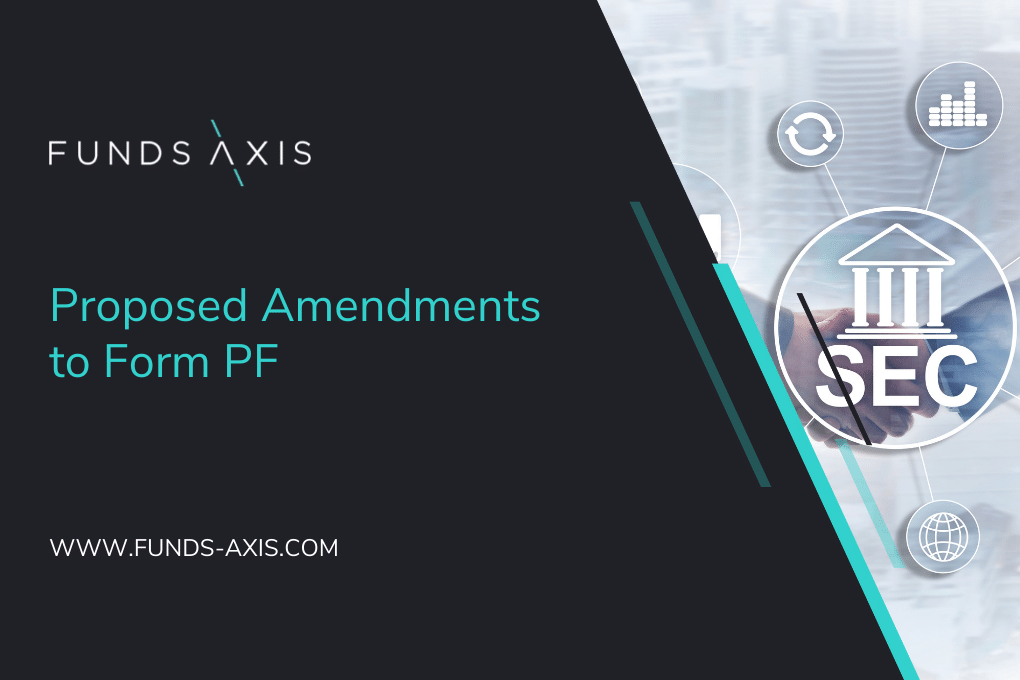Introduction
On the 26th January 2022, the Securities and Exchange Commission (SEC) voted to propose amendments to Form PF.
The proposed amendments would apply to large hedge fund advisers, private equity advisers, and large liquidity fund advisers. The proposals are designed to enhance FSOC’s ability to monitor systemic risk, bolster the Commission’s regulatory oversight of private fund advisers, and enhance investor protection efforts.
What is Form PF?
Form PF came into force on 31st March 2012 and requires investment advisers registered with the SEC that advise one or more “private funds” to file Form PF with the SEC.
Investment Advisers must complete and submit a Form PF if:
- The investment adviser is registered or required to register with the SEC as an investment adviser, or is registered or required to register with the Commodity Futures Trading Commission (CFTC) as a commodity pool operator or commodity trading advisor and are also registered or required to register with the SEC as an investment adviser; and
- The investment adviser manages one or more private funds; and
- The investment adviser or their related persons, collectively, had at least $150 million in private fund assets under management as of the last day of their most recently completed fiscal year.
Reporting frequency and deadline depend on the type of fund:
Large Hedge Funds must report on a Quarterly basis, within 60 days of each Quarter closing.
Large Liquid Funds must report on a Quarterly basis, within 15 days of each Quarter closing.
All other obligatory private funds must report on annual basis, within 120 days of the calendar year closing.
What are the key proposed changes?
The proposed amendments are designed to enhance FSOC’s monitoring and assessment of systemic risk and to provide additional information for FSOC’s use in determining whether and how to deploy its regulatory tools. The proposed amendments also are designed to collect additional data for the Commission’s use in its regulatory programs, including examinations, investigations and investor protection efforts relating to private fund advisers.
The proposed amendments would make three key changes to Form PF:
Firstly, the SEC are proposing new current reporting by large hedge fund advisers regarding their qualifying hedge funds and by private equity advisers upon the occurrence of certain key events.
Currently, Form PF requires advisers to file Form PF months after their quarter- and year-ends, depending on the size and type of private funds they advise. The SEC proposal would require large hedge fund advisers to file current reports within one business day of the occurrence of one or more reporting events with respect to their qualifying hedge funds pertaining to certain extraordinary investment losses, significant margin and counterparty default events, material changes in prime broker relationships, changes in unencumbered cash, operations events, and events associated with withdrawals and redemptions.
The proposal also would require advisers to private equity funds to file current reports within one business day of the occurrence of one or more reporting events pertaining to the execution of adviser-led secondary transactions, implementation of general partner or limited partner clawbacks, removal of a fund’s general partner, termination of a fund’s investment period, or termination of a fund. The proposal is designed to allow the SEC and FSOC to receive more timely information about certain events that may signal distress at qualifying hedge funds and private equity funds or market instability.
Secondly, the SEC are proposing to decrease the threshold for reporting as a large private equity adviser and to require additional information from these advisers.
The proposed amendments would reduce the threshold for reporting as a large private equity adviser from $2 billion to $1.5 billion in private equity fund assets under management. Lowering this threshold would enable the Commission and FSOC to receive reporting from a similar proportion of the U.S. private equity industry based on committed capital as when Form PF was initially adopted.
Additionally, the proposal would amend section 4 of Form PF for large private equity advisers to gather more information regarding fund strategies, use of leverage and portfolio company financings, controlled portfolio companies (“CPCs”) and CPC borrowings, fund investments in different levels of a single portfolio company’s capital structure, and portfolio company restructurings or recapitalizations. The proposed amendments are designed to provide useful empirical data to FSOC to better assess the extent to which private equity funds or their advisers may pose systemic risk and to inform the Commission in its regulatory programs for the protection of investors.
Finally, the SEC are proposing to require large liquidity fund advisers to report substantially the same information that money market funds would report on Form N-MFP, as the Commission proposes to amend it. Together, Form N-MFP and Form PF are designed to provide a complete picture of the short-term financing markets in which money market funds and liquidity funds both invest. The proposed amendments to Form PF are designed to enhance the Commission and FSOC’s ability to assess short-term financing markets and facilitate our oversight of those markets and their participants.
How Fund-Axis can help!
Funds-Axis supports a broad range of global regulatory reporting requirements.
We enable organisations to rapidly comply with these regulations, without the need to develop costly in-house solutions. The cost of compliance is significantly reduced through plug-and-play functionality, integrated data availability, automated report production and through availability as a hosted software as a service solution.
How it works:
- Holdings, trades and other data is captured once and re-used for all reporting;
- Data is enriched with security and market data;
- Data taxonomies are applied, consistent with regulatory requirements;
- All calculations are performed in the system (exposure, liquidity etc); and
- Regulatory compliance reports are available at the click of a button.






